More than half the cells in your brain aren’t actually neurons but cells called glia. The name means ‘glue’ and for well over a century after their discovery in the 1850s that’s pretty much all they were considered as – the passive glue holding together the important neurons. Scientists gradually realised that there are different types of glia and they performed varied roles in addition to just being a cushioned scaffold. They were found to provide neurons with growth factors and nutrients, enhance synaptic connections and protect against pathogens. The narrative was still very much that glia were the supporting cast to the neurons doing the heavy thinking. Neuroscientists went to their conferences to talk about nerve cells. Glial cell biologists went to theit own meetings to tell each other how awesome and unappreciated glia were. This split is parodied in one of my other works Neurons v Glia which clearly strikes a chord – or hits a raw nerve?! – given the love it gets on social media and the emails I’ve had from people who use it in their teaching. Despite coming come a decidely neurocentric background, I’ve been fortunate to work with some of the very best glial experts and have even published in Glia! I decided to use them as inspiration for a cartoon series that immersed the figures in a more substantial environment than the usual sketchy backgrounds I throw in as an afterthought. I’ve written a separate post about Astro Workshop, using it to explain the artistic thinking and process that go into my drawings. Here I present the full gallery of glia characters with a brief explanation of why I’ve given them that job. As explained in Astro Workshop, the shop sign took on a life of its own and I created a standalone design for each, shown below, which also features somewhere in the main setting. If you like these designs and would like to have them on some cool (and even useful) products, see the bottom of this page for links to get your hands on them.
Astrocytes
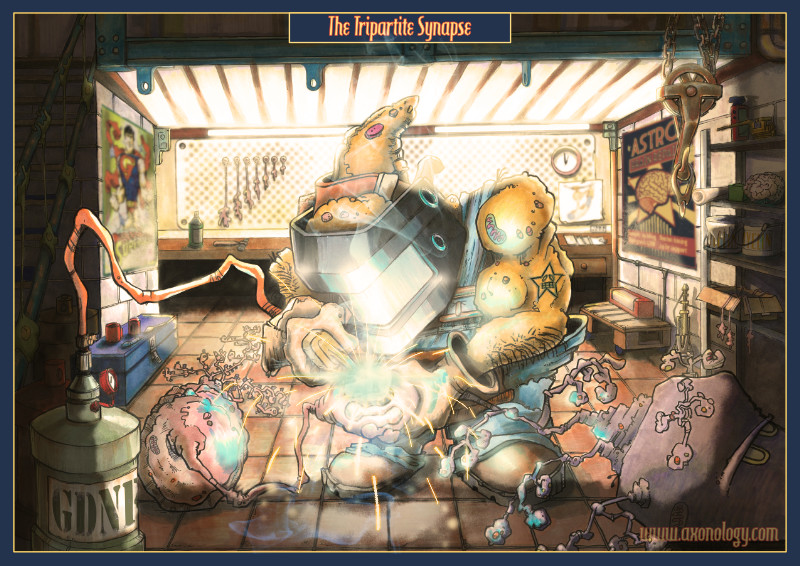
Astrocytes are the most numerous glia with several roles, explained on the Astro Workshop post. The one I chose to focus on was how they regulate the synaptic connections between neurons. Whereas a synapse was traditionally considered as a neuronal affair, modern neuroscience has embraced the concept of the tripartite synapse: the pre- and post-synaptic neurons and an astrocyte modulating the signalling. Astrocytes have a major influence on the strength of the connection and how it is modified in response to changing needs of the brain, a process known as neuroplasticity. This made me think of welding components together and it was a short step from there to see the astrocyte as a mechanic. I’ve added lots of details to this, mainly for my own amusement, the different sized axons hanging like spanners on the back wall; the pots of gooey myelin and the box of spare axons on the shelves. In addition to the main Astro Repair Shop poster, a couple of other Axonology originals have crept in – the poster of Superglia and pinned up under the clock an oligodendrocyte that I share on SciDraw (see also Swan and O’Ligo below).
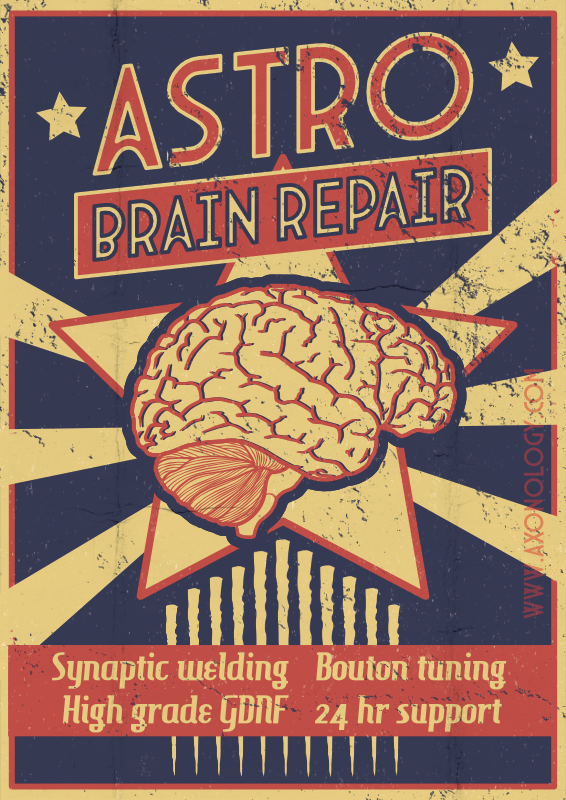
Microglia
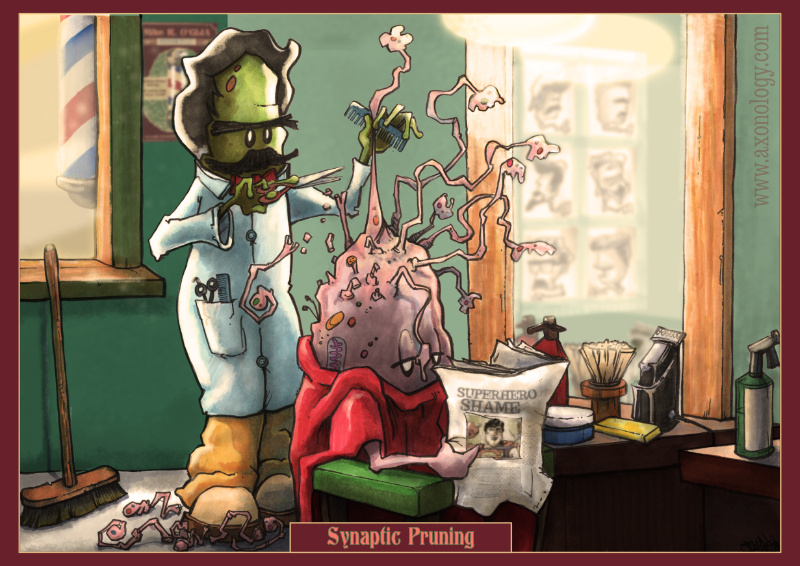
Microglia are a type of macrophage, you can find out more about their roles throughout the body elsewhere on Axonology. The brain is generally sealed off from the rest of the body to protect it from foreign substances of germs. A trade off of this is to also make it hard for immune cells that patrol the rest of the body to access the brain. As a result, microglia are like a private security force for the central nervous system, scanning for dnager and quickly fighting off infection or repairing damage. Whereas the body’s macrophages tend to commit to a particular role and are quickly replaced if they fall in combat, microglia need to be longer-lasting and adaptable. They can adopt a wide range of shapes and behaviours to fulfil different roles from defence to attack to cleaning up afterwards.
As well as dealing with invaders and injury, microglia have an important role modifying the underlying neural circuits. They can nibble away at synapses to change the strength of connections, contributing to the neuroplasticity described above. This was the subject of the one of the first cartoons I posted on Axonology, Synaptic Pruning. Google ‘synaptic pruning’ and you’ll find other variants on the theme, it’s a gift to cartoonists. I felt by fleshing out Mike and his barbershop, I could really make this stand out. Plus it meant a lot of the work was already done. Or so I thought. The first version of this was Synaptic Pruning simply copied with more background detail. I spent a long time just fiddling around with showing the door in a slightly wider perspective, adding a tiled floor and cabinets containing hairdressing sundries. The background details that worked for Astro Workshop just didn’t feel right here. Eventually, I drew the whole thing from scratch, changing the viewpoint and crucially moved the characters closer to the viewer. Instead of detailed walls, floor and cabinets which were boring to draw and not adding anything, I developed the figures. Mike is lit by two sources of light and there is more motion to the snipped axons falling to the floor. Rather than having the model photos directly on the wall, they are a blurred reflection in the mirror (this was a tough decision as I’d spent a lot of time drawing several of these in detail!). The customer’s newspaper now features our old friend Superglia, evidently fallen from the hero on the garage wall!
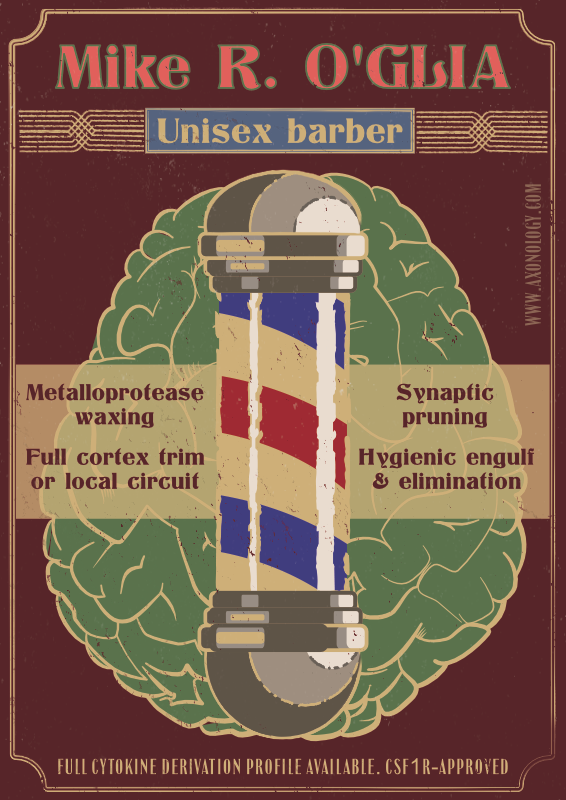
Ependymal cells
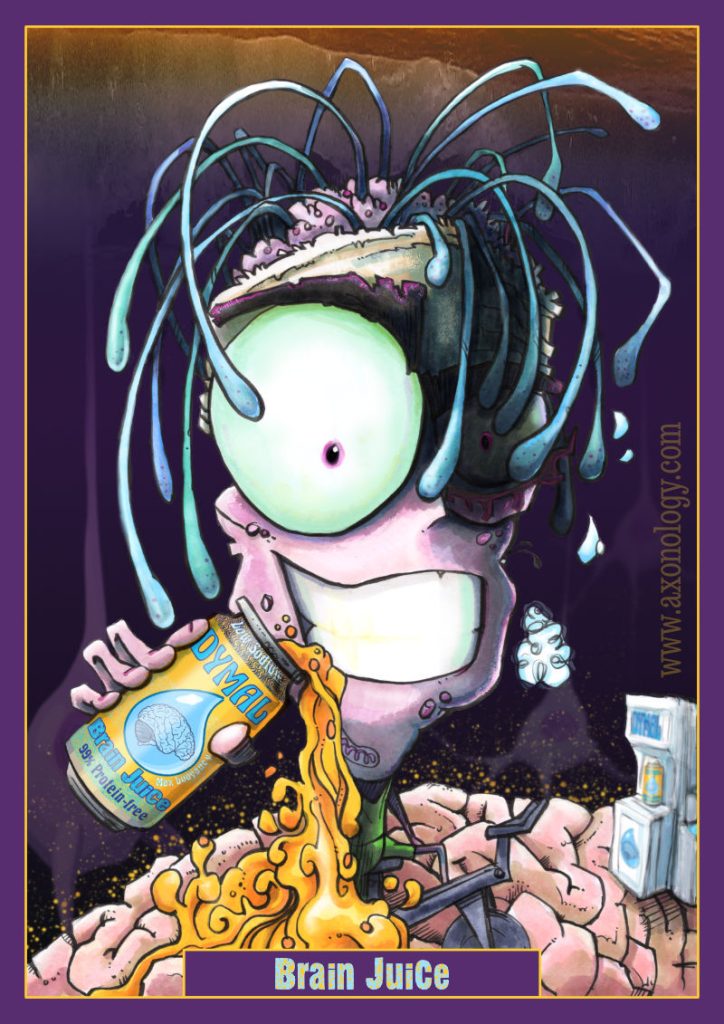
Ependymal cells line hollows in the brain known as ventricles and fill them with a liquid called cerebrospinal fluid (CSF). The standout physical feature of ependymal cells are the cilia on the side of the cell facing the ventricle. Cilia are long protrusions, like the arms of a sea anemone, found on cells other than these glia. In the case of ependymal cells, cilia collectively move in a sweeping motion, helping circulate the CSF around the central nervous system. They perform a similar role in your airways, sweeping mucus and dirt up and away from the lungs. They are damaged by cigarette smoke, one of the reasons smokers’ lungs fill up with so much gunk. Your brain floats in CSF. This is important because it stops it being squashed under its own weight. The fluid also acts as a shock absorber and helps distribute nutrients around the brain while washing away waste products. The cilia immediately gave me a character with big hair, the link to a nutrient fluid made me think of energy drinks and personal trainers. I decided on a deliberately vague background, hinting at the presence of neurons and also a wave washing over. My favourite bit is actually the poster which came directly from the branding on the can.
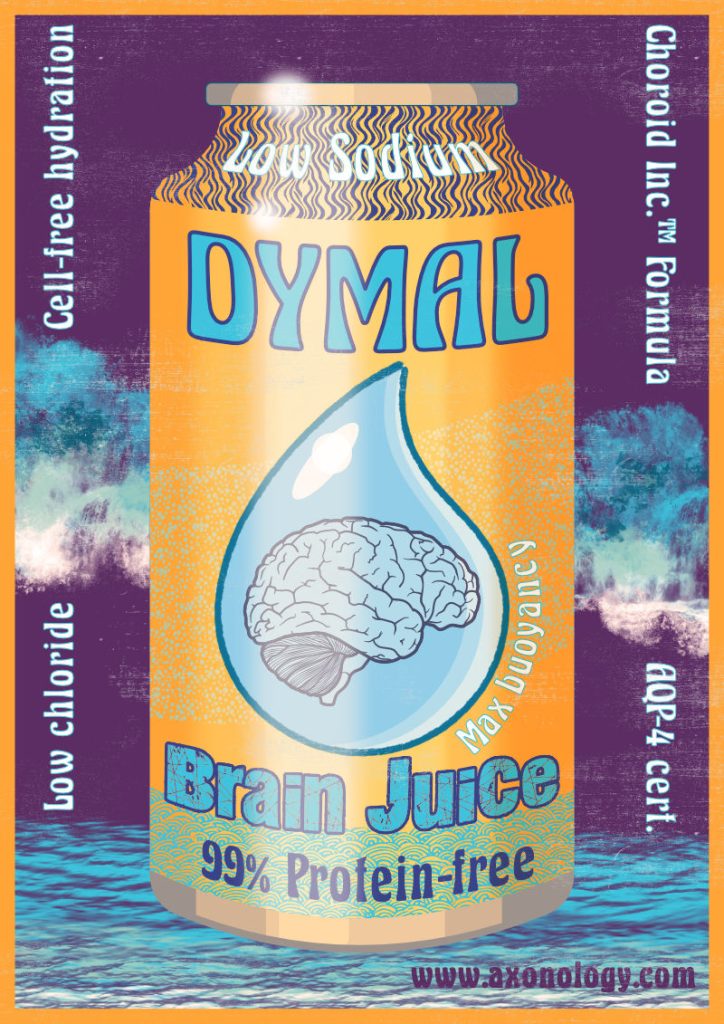
Schwann cells and oligodendrocytes
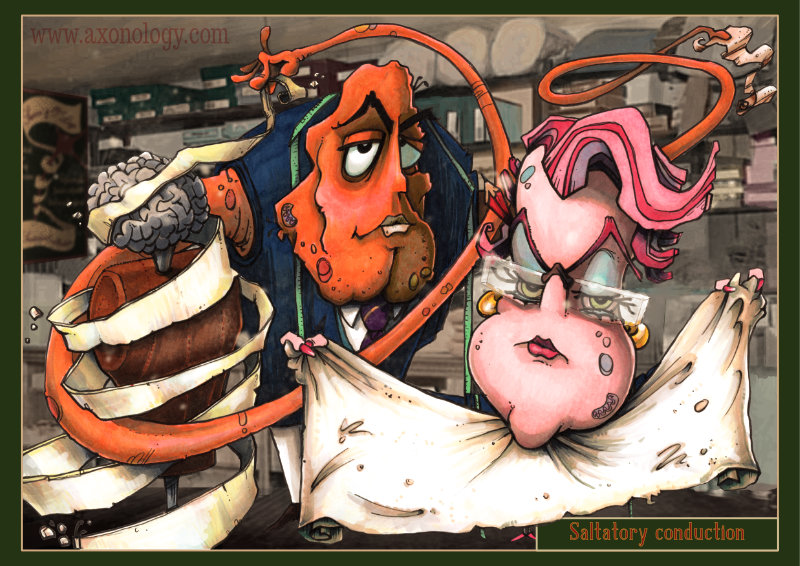
Most of your nerve cells are wrapped in a fatty sheath called myelin. This acts just like the insulation around an electrical wire, speeding up conduction and preventing short circuits. Unlike electrical insulation, the myelin has gaps, called nodes of Ranvier (after their discoverer), spaced along the length of the nerve fibre. These ensure fast conduction of action potentials in one direction only by a process called saltatory conduction (that I’ll explain elsewhere on the site sometime in the future). Saltation is jumping and these nodes basically allow the electrical signal to jump rapidly from one to the next like a series of relay boosters. Without these, nerve conduction would be much slower and less efficient. The problems associated with Multiple Sclerosis arise primarily from loss of myelin and signals not being carried effectively. In the central nervous system, that is the brain and spinal cord, glia called oligodendrocytes make myelin and wrap it round axons. In the peripheral nervous system, this is done by Schwann cells. The shared function made for a professional partnership and after briefly flirting with idea of rug sellers or mummifiers, I went for high-class tailors. I took the liberty of anglicising Schwann to Swan. This design sat half-finished for a long time. Like the first draft of microglia, I was fussing too much with a background that I didn’t like and not focussing on the figures. Compared to the initial plan, Swan and O’Ligo are standing closer together and nearer the viewer. The composition felt much tighter and engaging. At some point I should probably learn a lesson here… For the shop sign, I tried to recreate a sense of a vintage painted wooden board rather than a poster.
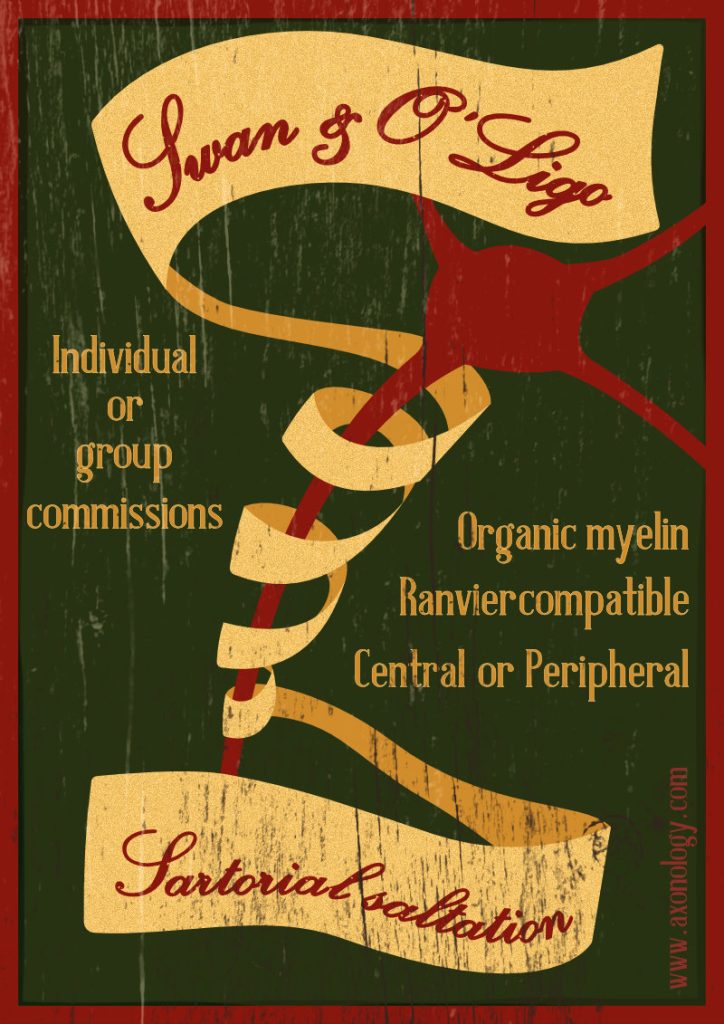
If you like any of these designs and would like to get them on a range of cool merch, here are links to the relevant pages of my RedBubble store (all open in a new tab). Enjoy!